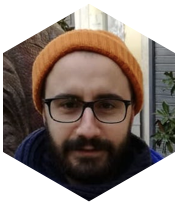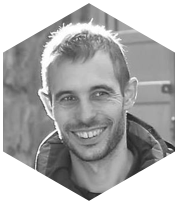Sorted by first name.
 |
Andrea Tramacere Andrea is a scientist and data scientist, at the Astronomy department of the University of Geneva, working on high energy astrophysics (acceleration and emission processes in relativistic jets), coding (Python/C), online data analysis (dispatcher/api/data processing), clustering methods and machine learning (photometric redshift/deblending of confused sources/gamma-ray detection). He is a member of the EUCLID consortium, and a former member (2002-2012) of the Fermi-LAT team (ISOC@SLAC). |
 |
Aneta Siemiginowska Aneta is a senior astrophysicist at Center for Astrophysics | Harvard and Smithsonian, and a member of the Science Data System team at the Chandra X-ray Center. She is the scientific lead of Sherpa, fitting and modeling application for Python. Her interests include astrostatistics issues related to high energy astrophysics data. |
 |
Atreyee Sinha Atreyee is a postdoc at the APC, Paris. After working on multi wavelength observations of blazars, she is presently a developer of Gammapy trying to understand the diffuse TeV emission in the Milky way and the LMC. |
 |
Axel Donath Axel is a postdoc at MPIK Heidelberg working on Gammapy and other codes, as well as the Galactic plane survey with H.E.S.S., Fermi-LAT and CTA. |
 |
Carlo Romoli Carlo is a postdoc at MPIK Heidelberg, interested in data analysis and modelling. His work has been focused on H.E.S.S. and Fermi-LAT data reduction and analysis, mostly for extra-galactic objects. He has started recently to maintain and develop the GAMERA toolkit for the modelling of astrophysical sources. |
 |
Catherine Boisson Catherine is an astronomer at the Observatoire de Paris, deputy head of the Paris Astronomical Data Centre and a member of the H.E.S.S. and CTA collaborations. Her research interest is mainly centered on the understanding of the structure and the fundamental source of energy of active nuclei of galaxies. |
 |
Christoph Deil Christoph is a postdoc at MPIK Heidelberg working on Gammapy, H.E.S.S. and CTA. He likes to talk about Python and Gammas, so once in a while he organises a PyGamma meeting. |
 |
Cosimo Nigro Cosimo is a PhD student at DESY Zeuthen and member of the MAGIC collaboration. He has contributed to the conversion of MAGIC data in a FITS-based open format for gamma-ray astronomical data. Along with other gamma-ray astronomers he proposed a first example of how a multi-instrument analysis can be produced relying only on open-access assets. His main research topics are gamma-ray data analysis and radiative process study for Active Galactic Nuclei. |
 |
Eric Charles Eric is a staff scientist at the Kavli Institute for Particle Astrophysics and Cosmology (KIPAC), working on the Fermi Large Area Telescope (Fermi-LAT) and the Large Synoptic Survey Telescope. He has contributed to the fermipy software package and maintains the Fermi-LAT likelihood analysis package. |
 |
Federico Montesino Pouzols Federico is a scientific software developer at ESO where he works as a software engineer in the ALMA Computing Team, as a member of the Pipeline Systems Group of the Science Operation Software Department, Directorate of Engineering. His current focus is on CASA (a software framework for calibration and analysis of radio astronomy data), the ALMA data processing pipeline, and TELCAL (the online calibration system of ALMA). |
 |
François-Xavier Pineau François-Xavier is a software engineer working at the Strasbourg Astronomical Data Center (CDS). He is currently working on the CDS HEALPix libraries and on both technical and statistical aspects of catalogues cross-matches. |
 |
Gernot Maier Gernot is a scientist at DESY (Zeuthen). He is working mostly on understanding high-energy emission from binary systems and is an expert on simulations and reconstruction methods for ground-based gamma-ray observatories. |
 |
Hans Dembinski Hans is a postdoc at MPIK Heidelberg working on LHCb. His big agenda is to solve the Muon Puzzle in air showers initiated by ultra-high energy cosmic rays. He made muon measurements with the Pierre Auger Observatory and the IceCube Neutrino Observatory, and then moved to the LHC to raise awareness about the Muon Puzzle and to propose new future measurements in order to resolve it. Also a skilled statistician and programmer in C++ and Python, he is the author of Boost.Histogram and maintainer of iminuit. |
 |
Jason Watson Jason is a postdoc at the University of Oxford. His primary responsibility is the calibration and analysis coordination for CHEC, one of the prototype camera designs for the Small-Sized Telescopes of CTA. He is an avid Python and C++ programmer, utilising them both to build the analysis and calibration framework for CHEC. He is also a contributor to the low-level data processing Python pipeline for CTA, known as ctapipe. |
 |
Jeremy Perkins Jeremy is a Research Astrophysicist at NASA/GSFC working on future high-energy gamma-ray missions like BurstCube, AMEGO, Nimble, and Bia. He got his start working on the ground-based experiments Whipple and VERITAS. He transitioned to the high-energy sky when he moved to NASA/GSFC to work in the Fermi Science Support Center and Fermi-LAT data analysis. |
 |
José Enrique Ruiz del Mazo José Enrique is an applied scientist at the Instituto de Astrofísica de Andalucía - CSIC. He has been working in projects related with the Virtual Observatory, astronomical archives and web services technologies. Gammapy contributor, he is interested in the characterization and reproducibility of the research analysis process made by astronomers with Python tools and virtual environments. |
 |
Joseph Asercion Joe is a software developer with the Fermi Science Support Center who works primarily on validating, packaging, and distributing the Fermitools (formally Fermi ScienceTools) data analysis suite. He is currently working on the software's transition to a Conda-based build/distribution pipeline and is interested in harnessing Python tools to support and maintain Fermi's software development processes in a sustainable way moving forward. |
 |
Josh Cardenzana Josh is a postdoc working at the Institut de Recherche en Astrophysique et Planétologie (IRAP) in Toulouse, France. The development of a source catalog pipeline targeting the planned CTA Galactic plane survey currently takes up most of his time. Additionally, Josh also contributes to the ctools and GammaLib analysis software. |
 |
Lars Mohrmann Lars is a postdoc working at ECAP in Erlangen, mostly on H.E.S.S. data analysis. He is working on enabling the analysis of H.E.S.S. data with open-source analysis tools and contributes to the Gammapy software package. |
 |
Léa Jouvin Léa is a postdoc at IFAE in Barcelona working on MAGIC and CTA LST commissioning. She first started to work with H.E.S.S. on the Galactic center and Gammapy and she is continuing to explore Galactic sources with MAGIC. She worked on the conversion of MAGIC data to the CTA DL3 format and she is completely convinced that Python is the future!!! |
 |
Mathieu Servillat Mathieu is a CNRS research engineer at the Observatoire de Paris, working on data access and analysis aspects of the next generation gamma-ray observatory CTA. He actively supports the use of Python in Astronomy and focuses on inter-operability solutions as a member of the International Virtual Observatory Alliance (IVOA). |
 |
Matthias Füßling Matthias is the Coordinator of the Science User Support System for the Cherenkov Telescope Array Observatory. |
 |
Matthieu Baumann Matthieu is a software engineer at CNRS Strasbourg Observatory. He participates to the development of several Python astronomical libraries such as mocpy, astroquery, regions and cdshealpix. He is currently investigating the integration of Rust codes into Python packages for multiple architectures. |
 |
J. Michael Burgess J. Michael is a Humboldt Fellow at MPE working on the analysis of gamma-ray bursts, AGN, and other astrophysical objects with an emphasis on Bayesian modeling. With collaborators, he began working on the open-source multi messenger analysis framework, 3ML to enable reproducible and statistically well-founded joint analysis of astrophysical data from different instruments. His current work focuses on Bayesian spectral analysis of GRB prompt emission with physical models as well as Bayesian hierarchal modeling of astrophysical populations. He’s not a fan of approximate likelihoods. |
 |
Michele Doro Michele is associate professor at University of Padova. He is publication manager for the MAGIC collaboration and member of the CTA consortium. His main science interests have been indirect dark matter with gamma rays. |
 |
Omar Laurino Omar is the lead developer of Sherpa, a modeling and fitting package for Python. He started his career in Astronomy by applying machine learning algorithms to astronomical data sets, before transitioning to a full-time software engineer. |
 |
Perry Greenfield Perry is a member of the Space Telescope Science Institute Data Analysis Tools Branch. He currently is working on astropy-related issues such as Generalized World Coordinate Systems, the modeling package, and the ASDF (Advanced Scientific Data Format) as well as metrology analysis for future telescopes. He has been involved in scientific Python since 1998. |
 |
Roberta Zanin Roberta is a postdoc at MPIK working mainly on H.E.S.S. and CTA and Gammapy. |
 |
Tamas Gal Tamas is PhD Student in Physics at the Erlangen Centre for Astroparticle Physics (ECAP) and the main developer of the Python/Cython based KM3Pipe analysis framework used in the KM3NeT project mainly for online and quasi-online data analysis. The aim of his thesis is online monitoring and live reconstruction and analysis of neutrino events seen by the KM3NeT neutrino telescope. His favourite languages are Python and JuliaLang for scientific computing and Haskell for fun. |
 |
Thomas Boch Thomas is a software engineer developing Aladin Lite and in charge of CDS services integration. He is co-author of several Virtual Observatory standards and participates to the development of several Python astronomical libraries (hipspy, ipyaladin, mocpy, astroquery.cds). |
 |
Toby Burnett Toby is currently Emeritus Professor of Physics at University of Washington, Seattle. Still active on Fermi-LAT, since 1996. Previously worked in experimental high energy physics, Crystal Ball, Mark III, SLD at SLAC; D0 at FNAL, Aleph and ATLAS at CERN. |
 |
Thomas Robitaille Tom is based in the UK and is the co-founder of Aperio Software, a company specializing in scientific software development. He is one of the coordinators and lead developers of the Astropy project (http://www.astropy.org) and lead developer of the glue package for multi-dimensional data exploration (https://glueviz.org/). |
